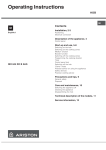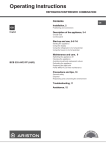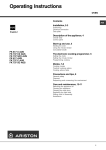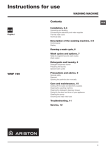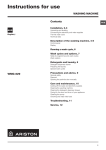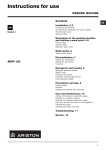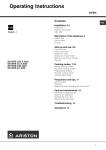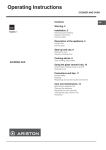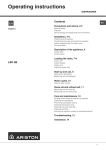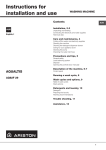Download Ariston CISTD 640 Operating instructions
Transcript
Operating Instructions HOB Contents Installation, 2-4 Positioning Electrical connection GB English,1 Description of the appliance, 5 Control panel Start-up and use, 6-9 NRA 640 C AUS Switching on the hob Switching on the cooking zones Switching off the cooking zones Heating elements Control panel lock Switching off the hob Practical advice on using the appliance Safety devices Practical cooking advice Precautions and tips, 10 General safety Disposal Care and maintenance, 11 Switching the appliance off Cleaning the appliance Disassembling the hob Technical description of the models, 12 Service information, 12 GB Installation this instruction booklet carefully. It contains important information concerning the safe operation, installation and maintenance of the appliance. ! Please keep these operating instructions for future reference. Pass them on to any new owners of the appliance. 5 mm ! Before operating your new appliance please read min. 20 mm COMPARTMENT ! A board must be installed under the hob if it is not installed above an oven. Please, refer to the “Installation Instructions” for minimum dimensions. min. 40 mm Positioning 90 56 0 +/1 52 0 /- 1 0+ 49 Ventilation To allow adequate ventilation and to avoid overheating of the surrounding surfaces the hob should be positioned as follows: • At a minimum distance of 40 mm from the back panel. • So that a minimum distance of 20 mm is maintained between the installation cavity and the cabinet underneath. • Kitchen cabinets adjacent to the appliance and taller than the top of the hob must be at least 600 mm from the edge of the hob. 2 FAN-ASSISTED OVEN min. 40 mm FRONT SIDE OF HOB SUPPORTING SURFACE UNDERSIDE OF HOB 30 Built-in appliance Use a suitable cabinet to ensure that the appliance functions properly. • The supporting surface must be heat-resistant up to a temperature of approximately 100°C. • If the appliance is to be installed above an oven, the oven must be equipped with a forced ventilation cooling system. • Avoid installing the hob above a dishwasher: if this cannot be avoided, place a waterproof separation device between the two appliances. • Depending on the hob you want to install, the cabinet must have the following dimensions (see figure): 5 min. 20 mm 40 children. It may present a choking or suffocation hazard (see Precautions and tips). ! The appliance must be installed by a qualified professional in accordance with the instructions provided. Incorrect installation may cause harm to people and animals or may damage property. 5 mm ! Keep all packaging material out of the reach of 48 GB Single-phase connection Fixing The appliance must be installed on a perfectly level supporting surface. Any deformities caused by improper fixing could affect the features and operation of the hob. The thickness of the supporting surface should be taken into account when choosing the length of the screws for the fixing hooks: • 30 mm thick: 17.5 mm screws • 40 mm thick: 7.5 mm screws Fix the hob as follows: 1. Use short flat-bottomed screws to fix the 4 alignment springs in the holes provided at the central point of each side of the hob. 2. Place the hob in the cavity, make sure it is in a central position and push down on the whole perimeter until the hob is stuck to the supporting surface. 3. For hobs with raised sides: After inserting the hob into its cavity, insert the 4 fixing hooks (each has its own pin) into the lower edges of the hob, using the long pointed screws to fix them in place, until the glass is stuck to the supporting surface. GB The hob is equipped with a pre-connected electricity supply cable, which is designed for single-phase connection. Connect the wires in accordance with the instructions given in the following table and diagrams: Voltage and mains frequency Electrical cable Wire connection : yellow/green 230-240V 1+N ~ 220-240V 1+N ~ 50/60 Hz N: the two blue wires together L: brown and black together Other types of connection If the mains supply corresponds with one of the following: Voltage and mains frequency • 400V - 2+N ~ 50/60 Hz • 220-240V 3 ~ 50/60 Hz • 230-240V 3 ~ 50/60 Hz • 400V - 2+2N ~ 50/60 Hz Separate the wires and connect them in accordance with the instructions given in the following table and diagrams: ! The screws for the alignment springs must remain accessible. ! In order to adhere to safety standards, the appliance must not come into contact with electrical parts once it has been installed. ! All parts which ensure the safe operation of the appliance must not be removable without the aid of a tool. Electrical connection Voltage and mains frequency Electrical cable 400V - 2+N ~ 50/60 Hz 230-240V 3 ~ 220-240V 3 ~ 50/60 Hz Wire connection : yellow/green; N: the two blue wires together L1: black L2: brown : yellow/green; 400V - 2+2N ~ 50/60 Hz N1: blue N2: blue L1: black L2: brown ! The electrical connection for the hob and for any built-in oven must be carried out separately, both for safety purposes and to make extracting the oven easier. Terminal board UNDERSIDE OF HOB On the lower part of the appliance there is a connection box for the different types of electricity supply (the picture is only an indication and is not an exact representation of the purchased model). If the mains supply corresponds with one of the following: Voltage and mains frequency • 400V 3 - N ~ 50/60 Hz proceed as follows: ! The cable provided is not suitable for the following types of installation. 1. Use a suitable supply cable, H05RR-F or higher, with the right dimensions (cable cross section: 25 mm). 2. To open the terminal board, use a screwdriver as a lever under the side tabs of the cover (see Terminal board picture). 3. Loosen the cable clamp screw and the terminal board screws in accordance with the type of 3 GB connection required and position the connection supports as shown in the following table and diagrams. 4. Position the wires in accordance with the information given in the following table and diagrams and connect the appliance by tightening all the screws for the springs as much as possible. Connecting the electricity supply cable to the mains Voltage and mains frequency Terminal board ! The installer must ensure that the correct electrical Three-phase 400 connection has been made and that it is fully compliant with safety regulations. Electrical connections 400V 3-N ~ 50/60 Hz 5. Secure the power supply cable by fastening the cable clamp screw, then put the cover back on. Phase Phase Phase Three-phase 400 4 5 Neutral 3 2 1 Earth U-bolt connection support If the appliance is being connected directly to the electricity mains an omnipolar switch must be installed with a minimum opening of 3 mm between contacts. Before connecting the appliance to the power supply, make sure that: • The appliance is earthed and the plug is compliant with the law. • The socket can withstand the maximum power of the appliance, which is indicated on the data plate located on the appliance itself. • The voltage falls within the range of values indicated on the data plate. • The socket is compatible with the plug of the appliance. If the socket is incompatible with the plug, ask an authorised technician to replace it. Do not use extension cords or multiple sockets. ! Once the appliance has been installed, the power supply cable and the electrical socket must be easily accessible. ! The cable must not be bent or compressed. ! The cable must be checked regularly and replaced by authorised technicians only. ! The manufacturer declines any liability should these safety measures not be observed. ! Do not remove or replace the power supply cable for any reason. Its removal or replacement will void the warranty and the CE marking. INDESIT does not assume liability for accidents or damage arising from replacement/removal of the original power supply cable. Replacement can only be accepted when carried out by personnel authorised by INDESIT and using an original spare part. 4 Description of the appliance Control panel GB The control panel described in this manual is only a representative example: it may not exactly match the panel on your appliance. TIMER* indicator light INCREASE POWER button PROGRAMME TIMER* display COOKING ZONE PROGRAMMED* indicator light POWER and RESIDUAL HEAT indicators COOKING ZONE SELECTED indicator light ON/OFF button ON/OFF indicator light CONTROLS LOCKED indicator light CONTROL PANEL LOCK button COOKING ZONE SELECTOR buttons PROGRAMME TIMER* button REDUCE POWER button • INCREASE POWER button switches on the hotplate and controls the power (see Start-up and use). • REDUCE POWER button controls the power and switches off the hotplate (see Start-up and use). • COOKING ZONE SELECTOR button shows a particular cooking zone has been selected and therefore various adjustments are possible. • COOKING ZONE SELECTOR button is used to select the desired cooking zone. • POWER indicator provides a visual display for the current heat level. • ON/OFF button switches the appliance on and off. • ON/OFF indicator light shows whether the appliance is on or off. • PROGRAMME TIMER* button controls the cooking programme times (see Start-up and use). • PROGRAMME TIMER* display shows which programme has been selected (see Start-up and use). • COOKING ZONE PROGRAMMED* indicator lights show which cooking zones are being used during a cooking programme (see Start-up and use). • CONTROL PANEL LOCK button prevents accidental changes to the hob settings (see Startup and use). • CONTROL PANEL LOCK indicator light shows the control panel has been locked (see Start-up and use). • TIMER* indicator light shows that the timer has been activated ! This product complies with the requirements of the latest European Directive on the limitation of power consumption of the standby mode. If no operations are carried out for a period of 2 minutes, after the residual heat indicator lights turn off and the fan stops (if present), the appliance automatically switches to the “off mode”. The appliance resumes the operating mode once the ON/OFF button is pressed. * Only available in certain models. 5 Start-up and use ! The glue applied on the gaskets leaves traces of GB grease on the glass. Before using the appliance, we recommend you remove these with a special nonabrasive cleaning product. During the first few hours of use there may be a smell of rubber which will disappear very quickly. electricity supply, a buzzer will sound. The hob may now be switched on. - + or button is pressed for an extended period of time, the display scrolls quickly though the power levels and timer minutes. Switching on the hob To switch the hob on, press and hold the button for approximately one second. Switching on the cooking zones Each cooking zone is controlled using a selector button - + and button. • To begin operating a cooking zone, press the corresponding control button and set the desired power level (between 0 and 9) using the buttons - + and . Power function the power level for the desired cooking zone as described in the previous paragraph. Press and hold the selector button corresponding to the desired for at least 2 seconds. The display, the power level indicator, will alternately P” and the power level set show the letter “P previously until the desired power level has been reached. Once this level has been reached, the display will revert to showing the set power level. To deactivate this function, press and hold – for at least 2 seconds - the selector button corresponding to the cooking zone on which the function has been activated; alternatively, select a different power level using the buttons 6 • Press the - + and . - and: button: the power of the cooking zone Heating elements Two types of heating element may be installed, depending on the appliance model: halogen and radiant elements. Halogen elements emit heat via radiation from the halogen lamps they contain. They have similar properties to gas burners: they are easy to control and reach set temperatures quickly, allowing you to see the power level instantly. Radiant elements consist of a series of coils which allow heat to be distributed evenly at the base of the cookware, so that all slow-flame cooking may be performed successfully, for example stews, sauces or reheated dishes. ! All the cooking zones may be programmed simultaneously, for a duration between 1 and 99 minutes. 1. Select the cooking zone using the corresponding selector button. 2. Adjust the power level of the cooking zone. 3. Press the The power function for the cooking zones may be used to shorten heating-up times. Activate and set cooking zone corresponding selector button Programming the cooking duration and a power adjustment device consisting of a double To switch off a cooking zone, select it using the will progressively decrease until it is switched off. ! A few seconds after the hob is connected to the ! If the Switching off the cooking zones programming button. The indicator light corresponding to the selected zone will start flashing. 4. Set the cooking duration using the - + and buttons. 5. Confirm by pressing the button or automatic selection occurs after 10 seconds. The timer begins counting down immediately. A buzzer sounds for approximately 1 minute and the cooking zone switches off when the set programme has finished. Repeat the above procedure for each hotplate you wish to programme. Using multiple programmes and the display If one or more hotplates are programmed, the display will show the data for the hotplate with the least time remaining, and the light corresponding to the position of the hotplate will flash. The lights corresponding to the other hotplates programmed will be switched on. To visualise the time remaining for the other programmed hotplates, press the button repeatedly: the time remaining for each hotplate will be shown sequentially in a clockwise order, starting from the front left hotplate. button repeatedly until the duration buttons to set the new duration. 3. Confirm by pressing the button. To cancel a programme, follow the above instructions. At step 2, press the - button: the duration decreases progressively until it reaches 0 and switches off. The programme resets and the display exits programming mode. Timer “Demo” mode It is possible to set the hob to a demonstration mode where all the controls work normally but the heating elements do not switch on. To activate the “demo” mode the hob must be switched on, with all the hotplates switched off. • Press and hold the programming button until the timer indicator light is illuminated . 2. Set the desired duration using the - + and buttons. 3. Confirm by pressing the + and buttons simultaneously for 6 seconds. When the 6 seconds have elapsed, the ON/OFF and CONTROLS LOCKED indicator lights will flash for one second. Release the press the The hob must be switched on. The timer can be used to set a duration up to 99 minutes. 1. Press the button to switch the appliance off. If the control panel lock has been activated, the controls will continue to be locked even after the hob is switched on again. In order to switch the hob on again, you must first remove the lock function. you wish to change is shown. 2. Use the GB Switching off the hob Press the Changing the programme 1. Press the button for a few moments, the indicator light will switch off and the lock function will be removed. + and buttons and button; • The display will show the text DE and MO and the hob will be switched off. • When the hob is switched on again it will be set to the “demo” mode. To exit this mode, follow the procedure described above. The display will show the text DE and OF and the hob will be switched off. When it is next switched on, the hob will function normally. Practical advice on using the appliance button. The timer begins counting down immediately. When the time has elapsed, a buzzer will sound (for one minute). To obtain the best results from your hob: • Use pans with a thick, flat base in order to fully utilise the cooking zone. Control panel lock When the hob is switched on, it is possible to lock the oven controls in order to avoid accidental changes being made to the settings (by children, during cleaning, etc.). Press the button to lock • Always use pans with a diameter which is large enough to cover the hotplate fully, in order to use all the available heat. the control panel: the indicator light above the button will switch on. To use any of the controls (e.g. to stop cooking), you must switch off this function. Press the 7 GB • Make sure that the base of the cookware is always clean and dry, in order to fully utilise and extend the life of both the cooking zones and the cookware. • Avoid using the same cookware which has been used on gas burners: the heat concentration on gas burners may distort the base of the pan, causing it not to adhere correctly. Safety devices Safety switch The appliance has a safety switch which automatically switches the cooking zones off after they have been in operation for a certain amount of time at a particular power level. When the safety 0”. switch has been triggered, the display shows “0 For example: the right rear hotplate is set to 5 and will switch off after 5 hours of continuous operation, while the front left hotplate is set to 2 and will switch off after 8 hours. Pan sensor Power level Maximum operating time in hours 1 9 2 8 3 7 4 6 5 5 6 4 Residual heat indicators 7 3 Each cooking zone is equipped with a residual heat indicator. This indicator signals which cooking zones are still at a high temperature. If the power display 8 2 9 1 Each cooking zone is equipped with a pan sensor device. The hotplate only emits heat when a pan with suitable measurements for the cooking zone is placed on it. If the indicator light is flashing, it may indicate: • An incompatible pan • A pan whose diameter is too small • The pan has been removed from the hotplate. shows , the cooking zone is still hot. It is possible, for example, to keep a dish warm or melt butter or chocolate. As the cooking zone cools, the power display will show . The display switches off when the cooking zone has cooled sufficiently. Overheating protection If the electronic elements overheat, the hob switches off automatically and F appears on the display, followed by a flashing number. When the temperature has reached a suitable level, this message disappears and the hob may be used again. 8 Buzzer This can also indicate several irregularities: • An object (a pan, cutlery, etc.) has been placed on the control panel for more than 10 seconds. • Something has been spilt on the control panel. • A button has been pressed for too long. All of the above situations may cause the buzzer to sound. Remove the cause of the malfunction to stop the buzzer. If the cause of the problem is not removed, the buzzer will keep sounding and the hob will switch off. Very low-flame cooking Low-flame cooking Medium-flame cooking High-flame cooking Very high-flame cooking Practical cooking advice ª • • ¶ ¶ § § S S ¢ ¢ £ ™ ™ ¡ GB Pressure cooking Pressure cooker Frying Grilling Boiling Crêpes Cooking on a high flame and browning (roasts, steaks, escalopes, fish fillets, fried eggs) Fast thickening (liquid juices) Boiling water (pasta, rice, vegetables) Milk Slow thickening (dense juices) Bain-marie cooking Low-flame cooking (stews) Chocolate sauce Pressure cooking after whistle Reheating dishes Keeping food hot 9 Precautions and tips GB ! This appliance has been designed and manufactured in compliance with international safety standards. The following warnings are provided for safety reasons and must be read carefully. This appliance conforms to the following European Economic Community directives: - 2006/95/EEC dated 12/12/06 (Low Voltage) and subsequent amendments; - 2004/108/EEC dated 15/12/04 (Electromagnetic Compatibility) and subsequent amendments; - 93/68/EEC dated 22/07/93 and subsequent amendments. - 1275/2008 stand-by/off mode. General safety ! Make sure that the air inlet behind the fan grille is never obstructed. The built-in hob should, in fact, be provided with suitable ventilation for the cooling of the electronic components used in the appliance. • The appliance was designed for domestic use inside the home and is not intended for commercial or industrial use. • The appliance must not be installed outdoors, even in covered areas. It is extremely dangerous to leave the appliance exposed to rain and storms. • Do not touch the appliance when barefoot or with wet or damp hands and feet. • The appliance must be used by adults only for the preparation of food, in accordance with the instructions outlined in this booklet. Any other use of the appliance (e.g. for heating the room) constitutes improper use and is dangerous. The manufacturer may not be held liable for any damage resulting from improper, incorrect and unreasonable use of the appliance. • Do not use the hob as a worktop or chopping board. • The glass ceramic hob is resistant to mechanical shocks, but it may crack (or even break) if hit with a sharp object such as a tool. If this happens, disconnect the appliance from the electricity mains immediately to avoid electric shock, and contact a Service Centre. • Ensure that power supply cables of other electrical appliances do not come into contact with the hot parts of the hob. • Remember that the cooking zones remain relatively hot for at least thirty minutes after they have been switched off. An indicator light provides a warning when residual heat is present (see Start-up and use). 10 • Keep any object which could melt away from the hob, for example plastic and aluminium objects, or products with a high sugar content. Be especially careful when using plastic film and aluminium foil or packaging: if placed on surfaces which are still hot, they may cause serious damage to the hob. • Always make sure that pan handles are turned towards the centre of the hob in order to avoid accidental burns. • When unplugging the appliance, always pull the plug from the mains socket; do not pull on the cable. • Never perform any cleaning or maintenance work without having disconnected the appliance from the electricity mains. • The appliance should not be operated by people (including children) with reduced physical, sensory or mental capacities, by inexperienced individuals or by anyone who is not familiar with the product. These individuals should, at the very least, be supervised by someone who assumes responsibility for their safety or receive preliminary instructions relating to the operation of the appliance. • Do not look at the halogen lamps in the cooking zones for long if they are present. • Do not let children play with the appliance. • The appliance is not intended to be operated by means of an external timer or separate remote-control system. • Children should be supervised to ensure that they do not play with the appliance. Care and maintenance Disposal • When disposing of packaging material: observe local legislation so that the packaging may be reused. • The European Directive 2002/96/EC relating to Waste Electrical and Electronic Equipment (WEEE) states that household appliances should not be disposed of using the normal solid urban waste cycle. Exhausted appliances should be collected separately in order to optimise the cost of re-using and recycling the materials inside the machine, while preventing potential damage to the atmosphere and to public health. The crossed-out dustbin is marked on all products to remind the owner of their obligations regarding separated waste collection. For further information relating to the correct disposal of exhausted household appliances, owners may contact the public service provided or their local dealer. Switching the appliance off Disconnect your appliance from the electricity supply before carrying out any work on it. Cleaning the appliance ! Do not use abrasive or corrosive detergents (for example, products in spray cans for cleaning barbecues and ovens), stain removers, anti-rust products, powder detergents or sponges with abrasive surfaces: these may scratch the surface beyond repair. ! Never use steam cleaners or pressure cleaners on the appliance. • It is usually sufficient simply to wash the hob using a damp sponge and dry it with absorbent kitchen towel. • If the hob is particularly dirty, rub it with a special glass ceramic cleaning product, then rinse well and dry thoroughly. • To remove more stubborn dirt, use a suitable scraper. Remove spills as soon as possible, without waiting for the appliance to cool, to avoid residues forming crusty deposits. You can achieve excellent results by using a rust-proof steel wire sponge - specifically designed for glass ceramic surfaces - soaked in soapy water. • If any plastic or sugary substances are accidentally melted on the hob, remove them immediately with the scraper, while the surface is still hot. • Once it is clean, the hob may be treated with a special protective maintenance product: the invisible film left by this product protects the surface from drips during cooking. This maintenance task should be carried out while the appliance is warm (not hot) or cold. • Always remember to rinse the appliance well with clean water and dry it thoroughly: residues can become encrusted during subsequent cooking processes. Stainless steel frame (only in models with outer frame) Stainless steel can be marked by hard water which has been left on the surface for a long time, or by cleaning products containing phosphorus. After cleaning, it is advisable to rinse the surface well and dry it thoroughly. If water is spilt on the surface, dry it quickly and thoroughly. ! Some hobs have an aluminium frame which is similar to stainless steel. Do not use any cleaning or degreasing products which are not suitable for use with aluminium. Disassembling the hob If it is necessary to disassemble the hob: 1. Loosen the screws fixing the alignment springs on each side. 2. Loosen the screws holding the fixing hooks in each corner. 3. Take the hob out of its installation cavity. ! Do not attempt to repair the appliance yourself. If the appliance breaks down, contact a Service Centre. 11 GB Technical description of the models GB 09/2011 - 195093633.00 XEROX FABRIANO This table provides a model-by-model list of the energy absorption values, type of heating elements and diameters of each cooking zone. Hobs Cooking zone Back Left Back Right Front Left Front Right Total power NRA 640 C AUS Power (W) H 2300 H 1400 H 1200 H 1800 Diameter (mm) 210 160 145 180 6700 Key: H = single hilight AUSTRALIA ARISIT PTY LIMITED 40-44 Mark Anthony Drive, Dandenong South, VIC 3175, Australia Fax: Service & Sales (03) 9768 0838 Email: [email protected] NEW ZEALAND ARISIT PTY LIMITED PO Box 68-140 Newton, Auckland 1145, New Zealand Fax: (09) 302 0077 Email: [email protected] 12 ARISTON PRIORITY SERVICE If you are not completely satisfied with your appliance or require service call: Australia Phone: 1300 815 589 New Zealand Phone: (09) 306 1020 GENUINE ACCESSORIES & SPARE PARTS A wide range of genuine accessories are available for your appliance call: Australia Phone: 03 9768 0888 New Zealand












